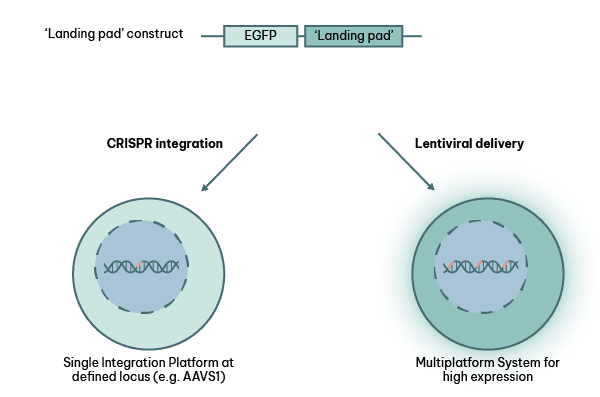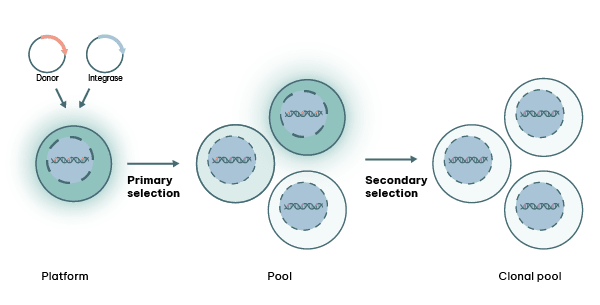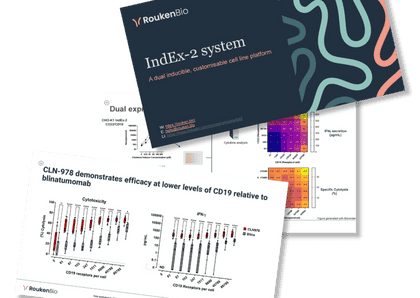Custom Cell Engineering for Drug Discovery
At RoukenBio, our cell engineering capability underpins many of the bespoke bioassays we deliver. We design and build custom cell lines that model specific immune pathways, receptor–ligand interactions, and disease-relevant biology. This includes the custom cell line development and custom cell line generation required to create complex tools for mechanism-of-action studies, potency assays, screening platforms and more.

Access our extensive in-house catalogue of engineered cell lines, including reporter lines and target-expressing lines. Our catalogue is continually updated with new additions with ready-to-use cell lines for various research applications. Utilise our rapid retargeting platform, LocIn to quickly modify cell lines for different target genes or pathways to accelerate the development process and enhance research flexibility.
Our Custom Cell Line Development Services
Our scientists combine deep immunology expertise with advanced molecular biology techniques to produce engineered cell lines that are stable, reproducible, and precisely tailored to your therapeutic modality. Every cell line engineering service we offer follows a collaborative, problem-solving approach, ensuring we build the right cellular system to answer the right biological question.
Inducible Expression with IndEx-2
LocIn – Targeted integration system
Gene Editing
Reporter Cell Lines
Target-Expressing Cell Lines
Defined Expression Levels
CAR-T Cells
Inducible Expression with IndEx-2
The IndEx-2 system evaluates antigen density and activation thresholds to address on-target, off-tumour side effects in antibody-targeted therapies. This system controls the expression of one or two proteins over a dynamic range, linking antigen density to activation thresholds for cytolysis and cytokine release. This innovative approach supports screening, characterisation, and lead selection for mono- and dual-targeted therapies.

Titratable expression of one or two antigens with a large dynamic range.
The utility of the system is characterised by three key attributes:
- Inducible expression of antigen(s): A cell line system that allows the expression of one or two antigens of interest, in a finely titratable manner and with large dynamic range of expression.
- Functional assays: A suite of functional assays utilising high content readouts, employing a well-characterised donor pool or even patient material.
- Threshold determination: An analysis methodology that enables the determination of activation thresholds.
The IndEx-2 assays system is a robust in vitro model to evaluate the influence of antigen expression levels on a targeted therapeutic’s efficacy and safety. This versatile tool enables the controlled expression of one or two antigens of interest, and uniquely allows for the estimation of antigen expression thresholds required for therapeutic activation.
SEE OUR WEBINARInducible Expression with IndEx-2
The IndEx-2 system evaluates antigen density and activation thresholds to address on-target, off-tumour side effects in antibody-targeted therapies. This system controls the expression of one or two proteins over a dynamic range, linking antigen density to activation thresholds for cytolysis and cytokine release. This innovative approach supports screening, characterisation, and lead selection for mono- and dual-targeted therapies.

Titratable expression of one or two antigens with a large dynamic range.
The utility of the system is characterised by three key attributes:
- Inducible expression of antigen(s): A cell line system that allows the expression of one or two antigens of interest, in a finely titratable manner and with large dynamic range of expression.
- Functional assays: A suite of functional assays utilising high content readouts, employing a well-characterised donor pool or even patient material.
- Threshold determination: An analysis methodology that enables the determination of activation thresholds.
The IndEx-2 assays system is a robust in vitro model to evaluate the influence of antigen expression levels on a targeted therapeutic’s efficacy and safety. This versatile tool enables the controlled expression of one or two antigens of interest, and uniquely allows for the estimation of antigen expression thresholds required for therapeutic activation.
LocIn – Targeted integration system
Precision, speed and control in every cell line integration with LocIn
LocIn is an advanced targeted integration system that allows the efficient generation of genetically identical isogenic mammalian cell lines. LocIn’s unique targeted integration and selection systems remove the need for the subcloning and analysis of clones, reducing both the time and effort required for cell line generation, without compromising quality.
The LocIn system allows for the accurate comparisons of construct designs, through the standardisation of integration patterns. By eliminating positional and context-dependent effects, LocIn enables accurate studies of phenotypic outcomes, delivering reliable genotype-to-phenotype correlations. This makes the system well suited for use in the generation of cell lines for toxicology species cross-reactivity assessments, as expression variability resulting from integration pattern differences across expression constructs is normalised.
LocIn single and multi-platform systems
LocIn offers both single and multi-platform systems to meet your cell line engineering needs, whether you require low or high expression.
- The single platform system allows the integration of your target into a landing pad within defined, single genomic locus in the platform cell line.
- The multiplatform system ensures the retargeting of multiple landing pads within the platform cell line, maximising expression.
With LocIn, you have precise control, minimising integration artefacts and ensuring consistency across experiments.
How does LocIn work?
LocIn is an advanced targeted integration system designed for the efficient generation of cell lines by retargeting pre-defined genomic loci, known as "landing pads." These landing pads incorporate a fluorescent protein marker, enabling the easy identification of integrations at genomic sites that support high transgene expression.

The system leverages Recombinase Mediated Cassette Exchange (RMCE) to precisely replace the landing pad cassette with a gene of interest. This approach ensures the complete removal of the original cassette during retargeting while exclusively integrating the desired gene. The two step selection process ensures that in the multiplatform system, all platforms are retargeted in the final clonal pool.

Why choose LocIn for your cell engineering needs?
- Speed – Achieve faster cell line engineering, cutting out the time-consuming sub-cloning step.
- Uniformity – Get consistent results every time, with the same integration pattern across all cell lines.
- Control – Reduce integration site artefacts and variability for more reliable results.
- Flexible platforms – Choose from single or multi-platform systems for low or high expression needs, with complete control over your cell line generation process.
Discover LocIn from its creator
Join Timothy London, Director of Molecular Biology & Cell Engineering and one of the key developers behind the advanced LocIn system, as he unveils it in our webinar.
Gene Editing
We utilise the royalty-free MAD7 CRISPR nuclease, enabling us to generate bespoke knockout or knock in cell lines for our customers. Such gene edited cell lines can be combined with our other technologies, such as the inducible IndEx-2 system, allowing the creation of cell line in a relevant background with inducible expression of the target antigen of interest.
Reporter Cell Lines
RoukenBio offers custom reporter cell lines to fit the needs of your specific assays, including bioluminescent and fluorescent reporter cell lines, checkpoint blockade reporters (such as PD-1/PD-L1 blockade) as well as fully artificial reporter systems that can be used to monitor the activation of receptor tyrosine kinases or G protein coupled receptors (GPCRs). We have a diverse range of ready to go reporter cell lines, ready to be utilised in assays in-house at RoukenBio, or be shipped to your facility for use in your own assays.

Reporter system engineered into HEK293 generated HEK STAT6 RE cells shows a dose-dependent IL-13 response.
Target-Expressing Cell Lines
Our in-house expertise in the design and generation of bespoke target expressing recombinant cell lines provides you with the best possible cell line for your specific needs. We also have an ever-growing collection of pre-developed target-expressing cell lines engineered to express specific targets of interest for drug screening and validation studies.

Engineered target cells were opsonised with an antibody drug molecule and incubated with cryopreserved PBMCs to determine ADCC activity as compared to a reference standard.
Defined Expression Levels
We have expertise in the utilisation of expression attenuation techniques to create recombinant stable cell lines with defined levels of expression of your target antigen(s). These cells lines can be used in vitro for modelling the expression levels of tumour associated target antigens found in both healthy and diseased tissues and used in in vivo mouse models, for investigating the effect of tumour cell target antigen density on the efficacy and safety profile of a therapeutic.
CAR-T Cells
Our cell line development experts have experience and expertise in the design of 1st to 4th generation chimeric antigen receptors (CARs). We have predeveloped protocols for the generation and expansion of CAR expressing primary αβ and γδ T cells. We also have in-house developed Jurkat NFAT luciferase reporter cell lines that can be used as a background for CAR expression. These primary or Jurkat CAR-T cells can be utilised as effector cells in our suite of functional assays.
Delve into real dual inducible data with IndEx-2
Discover the latest dual inducible IndEx-2 data and dive into two in-depth CAR-T case studies in our exclusive technical slide deck.
ACCESS THE TECHNICAL PRESENTATION
